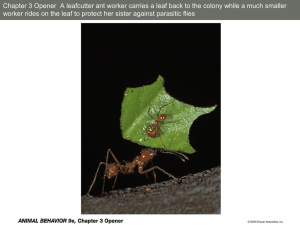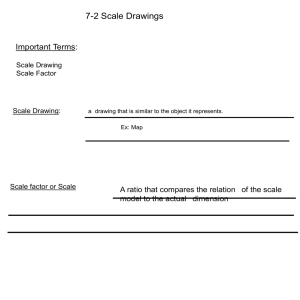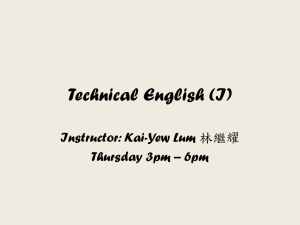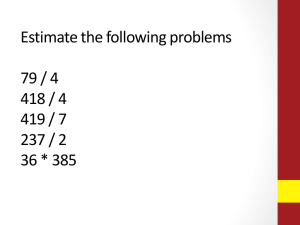Singapore Math pp
advertisement
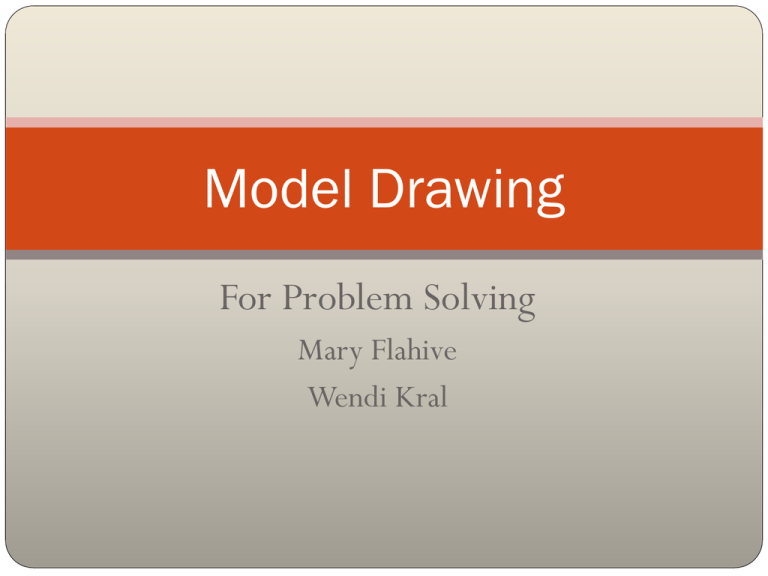
Model Drawing For Problem Solving Mary Flahive Wendi Kral What is Singapore Math Model Drawing? •Base-10 math program used in Singapore •Three part program Number sense is the overall understanding of a number. Mental math helps to develop this. Place Value is a student’s understanding of a digit’s position in a number. Model Drawing is a seven-step visual method of turning a word problem into a diagram with unit bars that represent values. History of Singapore Math Another nation that took the NCTM Standards and other research on problem-based approaches seriously is Singapore. After its independence in 1965, Singapore realized that without any natural resources it would have to rely on human capital for success, so they embarked on an effort to develop a highly educated citizenry. Various education reforms were initiated and in 1980 the Curriculum Development Institute was established, which developed the Primary Mathematics program. This program was based on the concrete, pictorial, abstract approach. This approach, founded on the work of renowned cognitive American psychologist Jerome Bruner, encourages mathematical problem solving, thinking and communication. From : The Daily Riff Bill Jackson Math Helping Teacher Scarsdale Public Schools Singapore math is not "drill and kill," facts memorization, or rote learning of procedures. In Singapore math, students learn their addition, subtraction and multiplication facts and eventually memorize them. But they also learn the structure and patterns behind the facts so if they forget them, they are able to reconstruct them in their minds. From early grades, children learn how to compose and decompose numbers and manipulate them in useful ways in order to calculate mentally. Singapore math is about students solving problems, thinking deeply, sharing their ideas, and learning from one another. Conceptual, procedural and factual understanding is developed through problem solving and carefully structured practice and as a result, students learn how to think deeply and appreciate mathematics. In 1983, prior to implementing this curriculum, Singapore ranked 17 out of 26 countries tested in eighth grade Mathematics. Just twelve years later, in 1995, Singapore ranked number one out of 41 countries tested at that level and remained number one in both 1999 and 2003. copyright 2007 Dr. Richard Bisk PROBLEM SOLVING WITH MODEL DRAWING The model drawing approach takes students from the concrete to the abstract stage via an intermediary pictorial stage. Students create bars and break them down into “units.” The units create a bridge to the concept of an “unknown” quantity that must be found. Students can learn to use this strategy in the primary grades and continue with it through the middle grades. copyright 2007 Dr. Richard Bisk Benefits of Model Drawing Students have one strategy for solving every problem. Students have a visual to associate with numbers that can be abstract. Students learn to translate the English into math and then back into English. Students start to see the relationship behind numerical values. Model Drawing is NOT the answer to every problem. Courtney starts with 12 birdhouses. She makes three new birdhouses each week. Which pattern shows the number of birdhouses Courtney has at the end of each week? Give one way that a cone and a cylinder are alike. NO One month Tony’s puppy grew 7/8 of an inch. The next month his puppy grew 5/8 of an inch. How many inches did Tony’s puppy grow in two months? Y Which spinner has a probability of 0 for landing on a star, ? What transformation changed shape 1 to shape 2? Mrs. Thomas gave the store clerk $25.00 for a pair of jeans. She received $2.88 back in change. What was the price of the jeans? Seven Steps for Model Drawing 1.Read the problem. 2.Identify the variables (the who and the what).. 3.Draw a unit bar or bars. 4.Chunk information by rereading the problem one sentence at a time, and adjust the unit bar or bars to match the information. 5.Decide on your question mark, and draw it in the appropriate place. 6.Work the computation. 7.Write a complete and grammatically correct sentence to answer your question mark. Step 1 - Read The Problem Mr. Hobart sells 6 pans of brownies every day. He makes $10 per pan. How much money does Mr. Hobart make in a day? •We can write a problem on the board and ask the whole class to read it aloud together. •We can ask each student to copy a problem from the board and read it to himself or herself silently. •We can ask each student to read the problem from his or her own paper in a low voice. •We can alternate calling on different students to read problems we put on the board. •We can read a problem to students. Step 2 Identify the Variables Who does or has what? How does that relate to what the other person or people do or have? Mr. Hobart sells 6 pans of brownies every day. He makes $10 per pan. How much money does Mr. Hobart make in a day? Step 3 Drawing Unit Bars Unit bars provide the visual. In early grade students can draw individual unit s, like fish, for unit bars We would like students to draw squares or rectangles of the same size for each unit bar. Mary’s Money Wendi’s brownies Sue’s brownies Step 4 Reread Each Sentence and Adjust Unit Bars Chunk information to make it more manageable. Adjust the unit bar or bars to match the information in the problem. This is where it is easy to make a mistake, work slowly. Mr. Hobart sells 6 pans of brownies every day. He makes $10 per pan. How much money does Mr. Hobart make in a day? The first sentence tells us he sold 6 pans of brownies every day. Next sentence tells us he makes $10 per pan. You want to write appropriate quantities either right above or below the bars in grades 3 and up. You can write inside the bars in lower grades. Step 5 Adding the Question Mark We add our question mark to indicate what we need to find out and where. Sometimes it surrounds multiple unit bars with a big bracket, and other times, it just relates to one part of one unit bar with a small bracket or no bracket at all. Step 6 Work the Computation Computations are done horizontally to match how we wrote it out in our model drawing. Step 7 Write a Sentence The sentence has to be complete. The sentence has to address the who and the what and the question mark. The sentence should be written underneath all the work. Mr. Hobart makes $60 in a day. Addition Problems-Golden Rules •Draw unit bars on the smaller side so you can add to them •You can also use pattern blocks for younger students to represent the units. Sean has 2 plastic cars. He also has 5 wooden cars. How many cars does Sean have altogether? Try It! Does your Model Drawing look something like this? Carlos read 221 pages of his book over the weekend. Jasmine read 198 pages. How many pages did Carlos and Jasmine read altogether? Carlos’ pages 221 ? Jasmine’s pages 198 Jesse had $3.00 more than Clinton. If Clinton had $10.00, how much money did they have altogether? Now we have two variables. What should we do? Try This One Penny ate 6 ice cream cones more than Jeff did over the weekend. If Jeff ate 8 ice cream cones, how many ice cream cones did they eat altogether? Three Whos John had 10 pencils, Andrew had 9 pencils, and Calvin had 5 pencils. They decided they'd put their pencils together and share them equally. How many pencils did each student get? Try It Ashley has 6 kittens, Dara has 3 kittens, and Noel has 3 kittens. They put their kittens in the same room to play. At the end of the day, they want to split the kittens equally. How many kittens will each child go home with? Subtraction Problems-Golden Rules Most subtraction problems require you to draw a longer unit bar to begin with. It's really helpful to identify the segment of the unit you're subtracting and draw a diagonal slash (sometimes called a vertical slash even though it's not exactly vertical) through the value. This is a great visual reminder. We usually place numerical values outside the unit bars with subtraction because we manipulate the inside of the units with sections and slashes. Nathan had $27.00 to buy gifts for his family. If he spent $9.00 on a gift for his brother, how much money did he have left to spend on the rest of his family? Nathan’s Money ? $9.00 $27.00 Diane had 106 stamps in her collection. She gave 12 away to a friend who was starting a collection. How many stamps did Diane have left? Ryan and Chris started out with an equal amount of baseball cards. Ryan lost 15 cards, and Chris collected another 45 cards. How many more cards did Chris have in the end? Ryan’s baseball cards 15 ? Chris’ baseball cards 45 Pablo and Nadine each had an equal number of chips. Pablo lost 12 chips, and Nadine got another 20 chips. How many more chips did Nadine have in the end? Multistep Problems The pep club made 425 buttons to sell on Friday. The club sold 75 more buttons in the morning than they did in the afternoon. If all the buttons were sold, how many buttons did the pep club sell in the morning? 2 units = 350 1 unit = 175 We need morning buttons 175 + 75 = 250 The Pep Club sold 250 buttons in the morning. Your Turn Belvedere's Chocolates made 350 truffles for a wedding. They gave away 46 more truffles at the sign-in table than they did at the dessert buffet. If all the truffles were passed out, how many truffles did Belvedere's give away at the sign-in table? Now we will practice problems that come from the textbook and the Exeter math sheets. Part II will be working on higher level problems, fractions, and percents.

